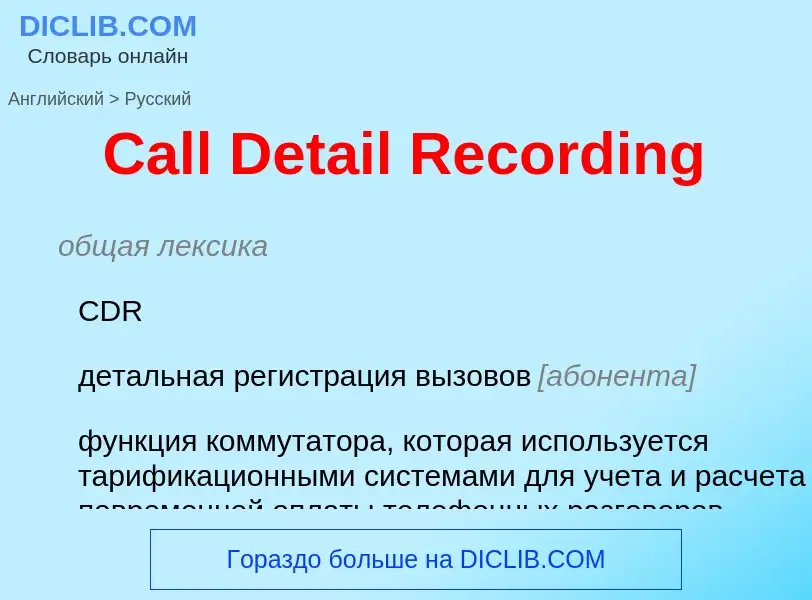Перевод и анализ слов искусственным интеллектом ChatGPT
На этой странице Вы можете получить подробный анализ слова или словосочетания, произведенный с помощью лучшей на сегодняшний день технологии искусственного интеллекта:
- как употребляется слово
- частота употребления
- используется оно чаще в устной или письменной речи
- варианты перевода слова
- примеры употребления (несколько фраз с переводом)
- этимология
Call Detail Recording - перевод на русский
Определение
1) Соотносящийся по знач. с сущ.: платина, связанный с ним.
2) Свойственный платине, характерный для нее.
3) Сделанный, изготовленный из платины.
Википедия
In computer science, a record (also called a structure, struct, or compound data) is a basic data structure. Records in a database or spreadsheet are usually called "rows".
A record is a collection of fields, possibly of different data types, typically in a fixed number and sequence. The fields of a record may also be called members, particularly in object-oriented programming; fields may also be called elements, though this risks confusion with the elements of a collection.
For example, a date could be stored as a record containing a numeric year field, a month field represented as a string, and a numeric day-of-month field. A personnel record might contain a name, a salary, and a rank. A Circle record might contain a center and a radius—in this instance, the center itself might be represented as a point record containing x and y coordinates.
Records are distinguished from arrays by the fact that their number of fields is determined in the definition of the record, and by the fact the records are a heterogenous data type; not all of the fields must contain the same type of data.
A record type is a data type that describes such values and variables. Most modern computer languages allow the programmer to define new record types. The definition includes specifying the data type of each field and an identifier (name or label) by which it can be accessed. In type theory, product types (with no field names) are generally preferred due to their simplicity, but proper record types are studied in languages such as System F-sub. Since type-theoretical records may contain first-class function-typed fields in addition to data, they can express many features of object-oriented programming.
Records can exist in any storage medium, including main memory and mass storage devices such as magnetic tapes or hard disks. Records are a fundamental component of most data structures, especially linked data structures. Many computer files are organized as arrays of logical records, often grouped into larger physical records or blocks for efficiency.
The parameters of a function or procedure can often be viewed as the fields of a record variable; and the arguments passed to that function can be viewed as a record value that gets assigned to that variable at the time of the call. Also, in the call stack that is often used to implement procedure calls, each entry is an activation record or call frame, containing the procedure parameters and local variables, the return address, and other internal fields.
An object in object-oriented language is essentially a record that contains procedures specialized to handle that record; and object types are an elaboration of record types. Indeed, in most object-oriented languages, records are just special cases of objects, and are known as plain old data structures (PODSs), to contrast with objects that use OO features.
A record can be viewed as the computer analog of a mathematical tuple, although a tuple may or may not be considered a record, and vice versa, depending on conventions and the specific programming language. In the same vein, a record type can be viewed as the computer language analog of the Cartesian product of two or more mathematical sets, or the implementation of an abstract product type in a specific language.

![Journal sheet from [[1880 United States Census]], showing tabular data with rows of data, each a record corresponding to a single person. Journal sheet from [[1880 United States Census]], showing tabular data with rows of data, each a record corresponding to a single person.](https://commons.wikimedia.org/wiki/Special:FilePath/1880 census Edison.gif?width=200)
![Hollerith [[punched card]] (1895) Hollerith [[punched card]] (1895)](https://commons.wikimedia.org/wiki/Special:FilePath/Hollerith Punched Card.jpg?width=200)

![WWV]], indicating its early location in the U.S. state of [[Maryland]] WWV]], indicating its early location in the U.S. state of [[Maryland]]](https://commons.wikimedia.org/wiki/Special:FilePath/QSL card sent to listener confirming reception of WWV from Maryland - 194007.jpg?width=200)
